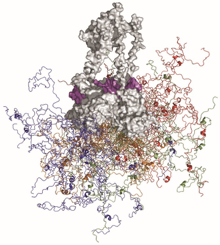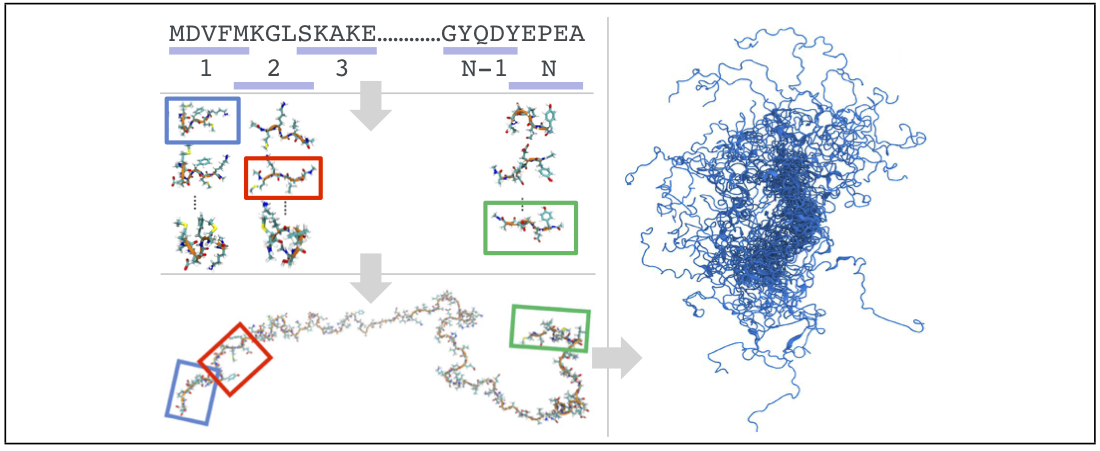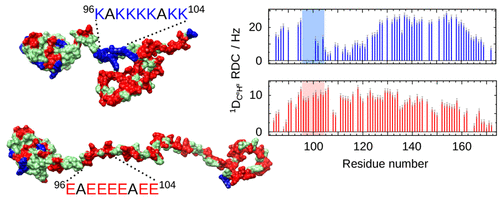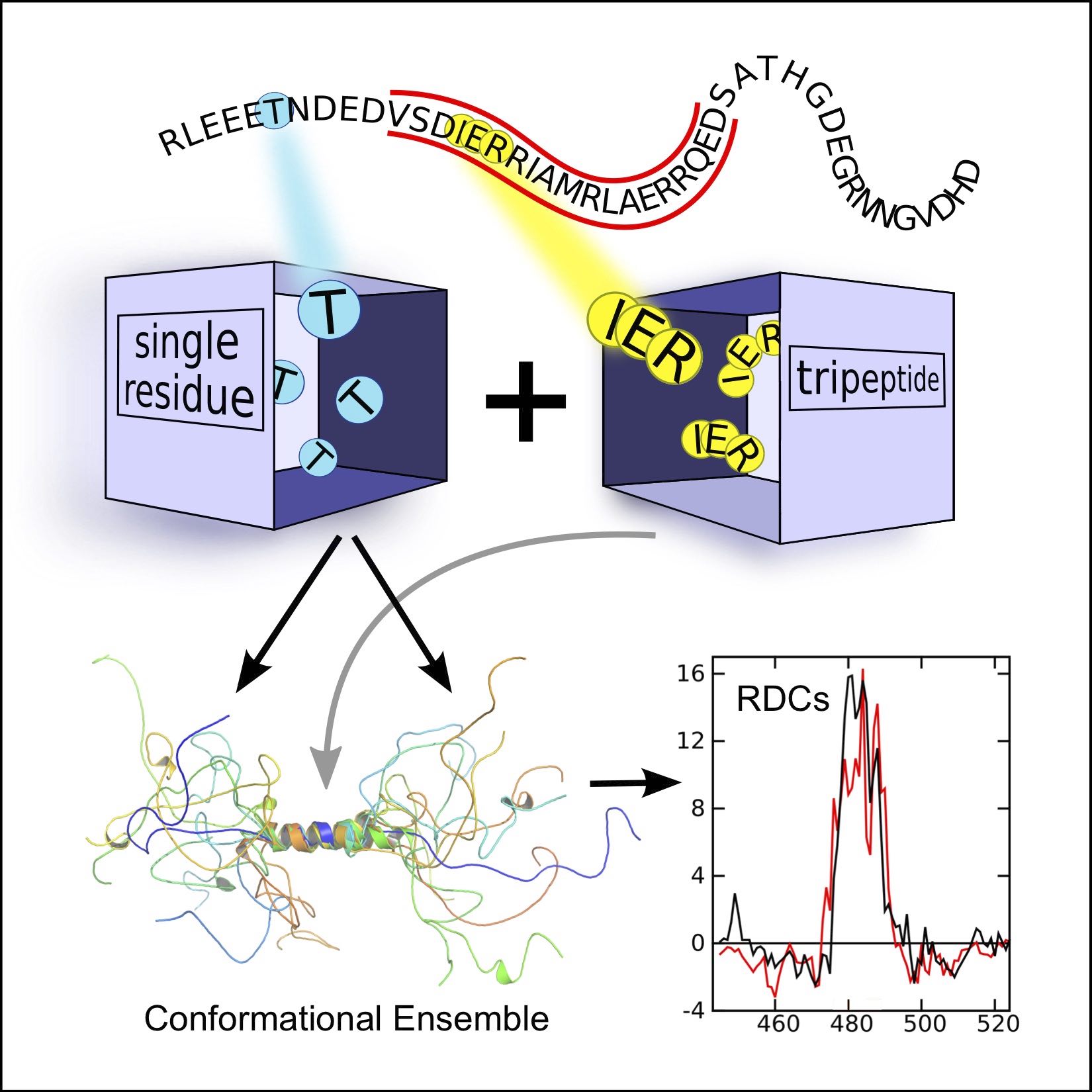Program
Lectures are from 9 AM to noon, Practicals from 2 to ~5 PM. (Exact times may vary)
- Monday : Introduction and overview of IDPs: from theory to practice
- Monday-bis : ≤ 3 min student introductions
- Monday (still) : Mixer apéro/mini-buffet
- Tuesday : Sampling the conformational space, structural, thermodynamic and kinetic modelling
- Wednesday : Connecting conformational ensembles to experimental results
- Thursday : Phase separation in the cell
- Thursday evening : IESC dinner
- Friday : Novel algorithms for exploring/characterizing high-dimensional conformational spaces
- ...departure: Friday session ends early to allow bus to Ajaccio airport
Links to lecture notes and practicals info will be added to each day as needed.
Monday, 21 Nov: Introduction and overview of IDPs
Peter Tompa, Vrije Universiteit Brussels, Belgium
Sonia Longhi, CNRS AFMB & Aix-Marseille Université, Marseille, France
Nathalie Sibille, CNRS Centre de Biochimie Structurale de Montpellier, France

Morning: a general introduction to intrinsically disordered proteins through a historical perspective to the most recent developments.
- brief history and basic concepts
- biophysical methods for the characterization of structural disorder
- functions and functional classification of disordered proteins
- structural disorder in diseases: can we target IDPs?
- ...
Afternoon: recent progress in database development
Tuesday, 22 Nov: Sampling the conformational space, structural, thermodynamic and kinetic modelling
Gerhard Hummer, Max Planck Institute for Biophysics, Frankfurt am Main, Germany
The practical session will be assisted by Johannes Betz, Henry Kim, and Maziar Haidari: Installation info

[Pietrek, Stelzl, & Hummer, J. Chem. Theory Comput. 2020]
Description of the practical session
- Hierarchical Chain Growth
- Working with complete code of a functional HCG implementation for a simplified case
- Bayesian Ensemble Refinement
- Reweighting the HGC ensemble according to SAXS data via Bayesian Inference of Enesembles (BioEn)
- Coarse-Grained Simulation
- Homopolymer model calculations
- MARTINI simulation of an IDP
- Comparison of Experimental Observables between Models
Wednesday, 23 Nov: Connecting conformational ensembles to experimental results
Martin Blackledge, Institut de Biologie Structurale, Grenoble, France
Practical session info is available at: Practical course info

- Statistical coil sampling of unfolded states
- Simulation of measurables and comparison with experimental values. Importance of averaging. This will include PREs, CSs, SAXS, RDCs.
- Simulation of NMR relaxation - importance of correct treatment of angular correlation functions/sampling of the conformational ensemble.
- Interactions between IDPs and partners - exchange methods and how these can be used to enhance our understanding of disorder in biology.
- Examples of the above, and biological insight that can be derived
Thursday, 24 Nov: Modelling phase separation in the cell
Jeetain Mittal, Chemical Engineering Department, Texas A&M University, College Station, Texas, USA
Jeetain Mittal's practical session installation info

The morning lecture and the afternoon practical will cover physics-based computational models that we have been developing in close collaboration with experimental collaborators for the last ten years.
The lecture will provide a broad overview of available atomistic and coarse-grained models and their relative benefits for specific research problems. A particular emphasis will be a discussion of models suitable for studying the liquid-liquid phase separation of proteins and nucleic acids.
The practical will cover the software and scripts necessary to use our coarse-grained modeling framework capable of providing molecular-level details on the sequence-determinants of protein phase separation due to specific disease mutations and the inclusion of a folded domain, and variation of chain length.
Thursday, 24 Nov: "Gala" Dinner at the IESC
Friday, 25 Nov: Novel algorithms for exploring and characterizing high-dimensional conformational spaces
Juan Cortés, CNRS LAAS, Toulouse, France
Frédéric Cazals, Inria, Sophia-Antipolis
A (short) practical session will be held, assisted by Javier Gonzalez-Delgado: Installation info
Part I:
- Modeling proteins in internal coordinates: a robotics-inspired approach
- Tripeptides as basic elements to model highly-flexible proteins and regions
- Structural propensity prediction from IDP sequences based on a structural database of tripeptides
- Generation of conformational ensemble models of IDPs/IDRs
Part II:
- Distance based structural measures: least RMSD and combined RMSD
- Nearest neighbor graphs of conformations and energy landscape models
- Persistence based analysis of energy landscapes
- Applications to IDPs
References:
- Predicting secondary structure propensities in IDPs using simple statistics from three-residue fragments; A. Estaña, A. Barozet, A. Mouhand, M. Vaisset, C. Zanon, P. Fauret, N. Sibille, P. Bernadó, J. Cortés; Submitted.
- Realistic ensemble models of intrinsically disordered proteins using a structure-encoding coil database; A. Estaña, N. Sibille, E. Delaforge, M. Vaisset, J. Cortés, P. Bernadó; Structure, 27(5): 381-391.e2, 2019
- A reinforcement-learning-based approach to enhance exhaustive protein loop sampling; A. Barozet, K. Molloy, M. Vaisset, T. Siméon, J. Cortés; Bioinformatics, 36(4): 1099-1106, 2020
- Characterizing molecular flexibility by combining lRMSD measures; F. Cazals, and R. Tetley; Proteins, 87 (5), 2019.
- Energy landscapes and persistent minima; J. Carr, and D. Mazauric, and F. Cazals, and D. Wales; The Journal of Chemical Physics, 144 (5), 2016
- Conformational Ensembles and Sampled Energy Landscapes: Analysis and Comparison; F. Cazals, and T. Dreyfus, and D. Mazauric, and A. Roth, and C.H. Robert; J. Comp. Chem., 36 (16), 2015.


